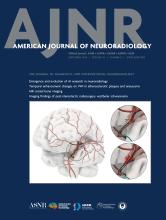Index by author
Schlemmer, Heinz-Peter
- Neuroimaging Physics/Functional Neuroimaging/CT and MRI TechnologyYou have accessWhole-Brain Vascular Architecture Mapping Identifies Region-Specific Microvascular Profiles In VivoAnja Hohmann, Ke Zhang, Christoph M. Mooshage, Johann M.E. Jende, Lukas T. Rotkopf, Heinz-Peter Schlemmer, Martin Bendszus, Wolfgang Wick and Felix T. KurzAmerican Journal of Neuroradiology September 2024, 45 (9) 1346-1354; DOI: https://doi.org/10.3174/ajnr.A8344
Schmidbauer, Victor U.
- Pediatric NeuroimagingOpen AccessSynthetic MRI and MR Fingerprinting–Derived Relaxometry of Antenatal Human Brainstem Myelination: A Postmortem-Based Quantitative Imaging StudyVictor U. Schmidbauer, Intesar-Victoria Malla Houech, Jakob Malik, Martin L. Watzenboeck, Rebecca Mittermaier, Patric Kienast, Christina Haberl, Ivana Pogledic, Christian Mitter, Gregor O. Dovjak, Astrid Krauskopf, Florian Prayer, Marlene Stuempflen, Tim Dorittke, Nikolai A. Gantner, Julia Binder, Dieter Bettelheim, Herbert Kiss, Christine Haberler, Ellen Gelpi, Daniela Prayer and Gregor KasprianAmerican Journal of Neuroradiology September 2024, 45 (9) 1327-1334; DOI: https://doi.org/10.3174/ajnr.A8337
Serrallach, Bettina L.
- NeurointerventionYou have accessIncidence, Risk Factors, and Clinical Implications of Subarachnoid Hyperdensities on Flat-Panel Detector CT following Mechanical Thrombectomy in Patients with Anterior Circulation Acute Ischemic StrokeBettina L. Serrallach, Mattia Branca, Adnan Mujanovic, Anna Boronylo, Julie M. Hanke, Arsany Hakim, Sara Pilgram-Pastor, Eike I. Piechowiak, Jan Gralla, Thomas Meinel, Johannes Kaesmacher and Tomas DobrockyAmerican Journal of Neuroradiology September 2024, 45 (9) 1230-1240; DOI: https://doi.org/10.3174/ajnr.A8277
Shaibani, Ali
- FELLOWS' JOURNAL CLUBNeurovascular/Stroke ImagingYou have accessTemporal Changes on Postgadolinium MR Vessel Wall Imaging Captures Enhancement Kinetics of Intracranial Atherosclerotic Plaques and AneurysmsAbhinav Patel, Ramez N. Abdalla, Sammy Allaw, Donald R. Cantrell, Ali Shaibani, Frances Caprio, David M. Hasan, Ali Alaraj, Sean P. Polster, Timothy J. Carroll and Sameer A. AnsariAmerican Journal of Neuroradiology September 2024, 45 (9) 1206-1213; DOI: https://doi.org/10.3174/ajnr.A8370
MR VWI in patients with symptomatic intracranial atherosclerotic disease plaques and aneurysms showed contrast accumulation beyond the early-phase (5–15 min) into the delayed phase (20–30 min). This nonspecific enhancement may indicate focal inflammation, neoangiogenesis, and/or increased permeability. The authors advocate postcontrast imaging soon after contrast administration to optimize diagnostic accuracy.
Shekhrajka, Nitesh
- EDITOR'S CHOICEHead and Neck ImagingYou have accessRetrolabyrinthine Bone Thickness as a Radiologic Marker for the Hypoplastic Endotype in Menière DiseaseAmy F. Juliano, Kuei-You Lin, Nitesh Shekhrajka, Donghoon Shin, Steven D. Rauch and Andreas H. EckhardAmerican Journal of Neuroradiology September 2024, 45 (9) 1363-1369; DOI: https://doi.org/10.3174/ajnr.A8339
There are 2 major endotypes of Menière disease: one with a hypoplastic, underdeveloped endolymphatic sac and one with a normally developed sac that degenerates over time. This study explored the link between angular trajectory of the vestibular aqueduct and the thickness of the retrolabyrinthine bone to provide differentiation between MD endotypes using CT and MRI. The average retrolabyrinthine bone thickness was statistically significantly different between endotypes with retrolabyrinthine bone thickness >=1.2 mm, effectively ruling out hypoplastic Menière disease.
Shi, Wenyin
- Brain Tumor ImagingYou have accessSex-Specific Differences in Patients with IDH1–Wild-Type Grade 4 Glioma in the ReSPOND ConsortiumSree Gongala, Jose A. Garcia, Nisha Korakavi, Nirav Patil, Hamed Akbari, Andrew Sloan, Jill S. Barnholtz-Sloan, Jessie Sun, Brent Griffith, Laila M. Poisson, Thomas C. Booth, Rajan Jain, Suyash Mohan, MacLean P. Nasralla, Spyridon Bakas, Charit Tippareddy, Josep Puig, Joshua D. Palmer, Wenyin Shi, Rivka R. Colen, Aristeidis Sotiras, Sung Soo Ahn, Yae Won Park, Christos Davatzikos, Chaitra Badve and on behalf of the ReSPOND ConsortiumAmerican Journal of Neuroradiology September 2024, 45 (9) 1299-1307; DOI: https://doi.org/10.3174/ajnr.A8319
Shin, Donghoon
- EDITOR'S CHOICEHead and Neck ImagingYou have accessRetrolabyrinthine Bone Thickness as a Radiologic Marker for the Hypoplastic Endotype in Menière DiseaseAmy F. Juliano, Kuei-You Lin, Nitesh Shekhrajka, Donghoon Shin, Steven D. Rauch and Andreas H. EckhardAmerican Journal of Neuroradiology September 2024, 45 (9) 1363-1369; DOI: https://doi.org/10.3174/ajnr.A8339
There are 2 major endotypes of Menière disease: one with a hypoplastic, underdeveloped endolymphatic sac and one with a normally developed sac that degenerates over time. This study explored the link between angular trajectory of the vestibular aqueduct and the thickness of the retrolabyrinthine bone to provide differentiation between MD endotypes using CT and MRI. The average retrolabyrinthine bone thickness was statistically significantly different between endotypes with retrolabyrinthine bone thickness >=1.2 mm, effectively ruling out hypoplastic Menière disease.
Simsek, Onur
- Pediatric NeuroimagingYou have accessThird Ventricle Diameter Is Inversely Related to Thalamic Massa Intermedia Thickness in Hydrocephalus Caused by Congenital Aqueductal StenosisOnur Simsek, Amirreza Manteghinejad, Apoorva Kotha and Matthew T. WhiteheadAmerican Journal of Neuroradiology September 2024, 45 (9) 1316-1321; DOI: https://doi.org/10.3174/ajnr.A8340
Skolnick, Gary B.
- EDITOR'S CHOICEArtificial IntelligenceYou have accessMR Cranial Bone Imaging: Evaluation of Both Motion-Corrected and Automated Deep Learning Pseudo-CT Estimated MR ImagesAndrew D. Linkugel, Tongyao Wang, Parna Eshraghi Boroojeni, Cihat Eldeniz, Yasheng Chen, Gary B. Skolnick, Paul K. Commean, Corinne M. Merrill, Jennifer M. Strahle, Manu S. Goyal, Hongyu An and Kamlesh B. PatelAmerican Journal of Neuroradiology September 2024, 45 (9) 1284-1290; DOI: https://doi.org/10.3174/ajnr.A8335
In this study, the authors developed automated motion correction and used deep learning to generate pseudo-CT cranial images from MR images. Compared with CT, pseudo-CT had 100% specificity and 100% sensitivity for suture closure and 100% specificity and 90% sensitivity for skull fractures.
Sloan, Andrew
- Brain Tumor ImagingYou have accessSex-Specific Differences in Patients with IDH1–Wild-Type Grade 4 Glioma in the ReSPOND ConsortiumSree Gongala, Jose A. Garcia, Nisha Korakavi, Nirav Patil, Hamed Akbari, Andrew Sloan, Jill S. Barnholtz-Sloan, Jessie Sun, Brent Griffith, Laila M. Poisson, Thomas C. Booth, Rajan Jain, Suyash Mohan, MacLean P. Nasralla, Spyridon Bakas, Charit Tippareddy, Josep Puig, Joshua D. Palmer, Wenyin Shi, Rivka R. Colen, Aristeidis Sotiras, Sung Soo Ahn, Yae Won Park, Christos Davatzikos, Chaitra Badve and on behalf of the ReSPOND ConsortiumAmerican Journal of Neuroradiology September 2024, 45 (9) 1299-1307; DOI: https://doi.org/10.3174/ajnr.A8319








